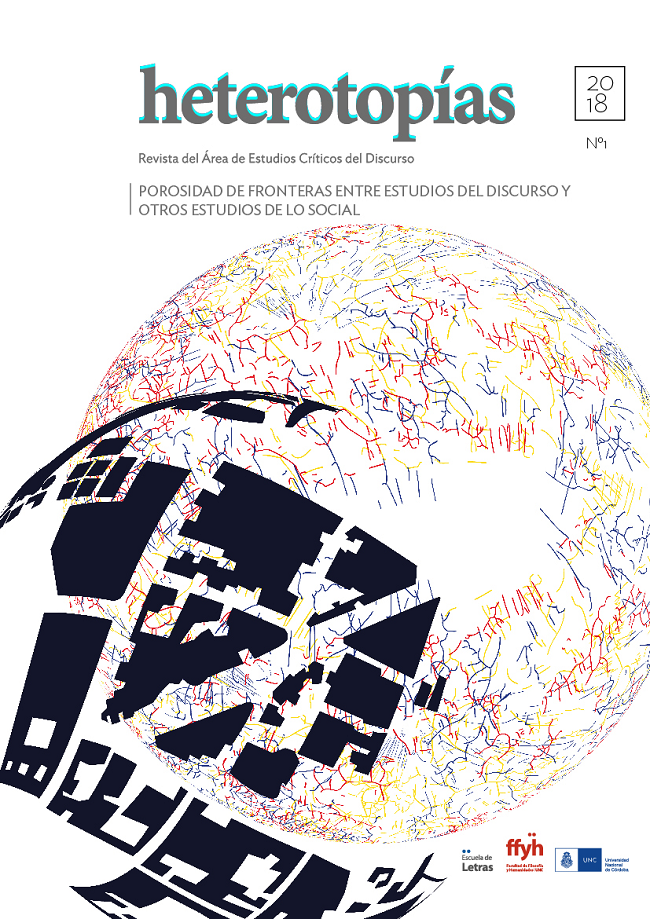Itinerarios de aborto. Un acercamiento a los recorridos de mujeres que buscan interrumpir un embarazo no deseado en contextos de clandestinidad?
Main Article Content
Abstract
This article aims to present a description and qualitative analysis of the routes that women take in order to clandestinely interrupt unwanted pregnancies. It can be placed within the discussions in Feminist Geography, and its interest in the relation between space and gender. From this perspective, we propose the category of "abortion itineraries" as an analytic tool to address the spaciality that is implied in the experience of women who have got an abortion and the power relations in which they are inscribed. The conceptualization of these itineraries is based on the selection of sense/meaning units emerging from the analysis of 7 in-depth interviews. The grouping of these units leads to the proposal of three categories that intends to understand the link between affections and spaciality in a context of penalized abortion.
Downloads
Article Details
Those authors who have publications with this journal, accept the following terms: Those authors who have publications with this journal, accept the following terms:
a. The authors will keep their copyright and guarantee to the journal the right of first publication of their work, which will be simultaneously subject to the Creative Commons Attribution - Non-Commercial - Share Alike (by-nc-sa) Attribution License; no commercial use of the original work or any derivative works is allowed, the distribution of which must be done with a license equal to the one that regulates the original work.
b. Authors may adopt other non-exclusive license agreements for the distribution of the published version of the work (e.g., deposit it in an institutional telematic archive or publish it in a monographic volume) provided that the initial publication in this journal is indicated.
c. Authors are allowed and recommended to disseminate their work through the Internet (e.g. in institutional telematic archives or on their website) before and during the submission process, which may lead to interesting exchanges and increase the number of citations of the published work. (See The effect of open access).
How to Cite
References
AHMED, Sara. (2015). La política cultural de las emociones. México, D. F.: Programa Universitario de Estudios de Género.
ASOCIACIÓN POR LOS DERECHOS CIVILES. (2015). Acceso al aborto no punible en Argentina: Estado de situación. Buenos Aires: Autor.
BERGALLO, Paola. (Comp.). (2010). Justicia, género y reproducción. Buenos Aires: Libraria.
CAMACARO CUEVAS, Marbella. (2008). “La construcción discursiva médico-obstétrica en el proceso reproductivo de las mujeres”. Ensayo y error. 35, 95-115.
CARBAJAL, Mariana. (2010). El aborto en debate. Aportes para una discusión pendiente. Dossier. Buenos Aires: Católicas por el Derecho a Decidir Argentina y Asociación por los Derechos Civiles.
DE ANGELIS, Susan. (2005). El método comparativo constante. Buenos Aires: Infancia en Red. Proyecto Margarita (inédito). Recuperado de: https://documents.mx/documents/metodo-comparativo-constante.html.
DEL VALLE, Teresa. (1997). Andamios para una nueva ciudad. Lecturas desde la antropología. Madrid: Ediciones Cátedra, S. A.
FEDERICI, Silvia. (2015). Calibán y la bruja. Mujeres, cuerpo y acumulación originaria. Buenos Aires: Tinta Limón.
FLORES, Valeria. (2015). “Afectos, pedagogías, infancias y heteronormatividad. Reflexiones sobre el daño”. XX Congreso Pedagógico UTE. Poéticas de las pedagogías del Sur: Educación, emancipación e igualdad. Recuperado de: http://educacionute.org/wp-content/uploads/2016/05/Afectos-pedagogias-infancias-heteronormatividad-PONENCIA-2.pdf.
FOUCAULT, Michel. (2014). Historia de la sexualidad 1: la voluntad de saber. Buenos Aires: Siglo Veintiuno Editores.
GARCÍA RAMÓN, María Dolors. (2008). “¿Espacios asexuados o masculinidades y feminidades espaciales?: hacia una geografía del género”. Ciencias Sociais e Humanidades. 20, 25-51.
HARAWAY, Donna. (1999). “Las promesas de los monstruos: una política regeneradora para otros inapropiados/bles”. Política y Sociedad, 30, 121-163.
LEFEBVRE, Henri. (2013). La producción del espacio. España: Capitán Swing.
MCDOWELL, Linda. (2000). Género, identidad y lugar. Madrid: Editorial Cátedra.
MORÁN FAÚNDES, J. M. (2013). “¿Pro-vida? ¿Cuál vida? Hacia una descripción crítica del concepto de "vida" defendido por la jerarquía católica”. En ZURBRIGGEN, Ruth, y ANZORENA, Claudia (Comps.). El aborto como derecho de las mujeres. Otra historia es posible (pp. 39-59). Buenos Aires: Herramienta.
PÁRAMO, Pablo y BURBANO, Andrea Milena. (2011). “Género y espacialidad: análisis de factores que condicionan la equidad en el espacio público urbano”. Universitas Psychologica, 10(1), 61-70.
RODRÍGUEZ, Rosana Paula. (2013). “Itinerarios corporales de aborto en mujeres argentinas y españolas”. En ZURBRIGGEN, Ruth, y ANZORENA, Claudia (Comps.) El aborto como derecho de las mujeres. Otra historia es posible (pp. 263-281). Buenos Aires: Herramienta.
ROSE, Gillian. (1993). Feminism & Geography. The limits of geographical knowledge. USA: Polity Press.
ROSTAGNOL, Susana. (2013). “Aborto voluntario y relaciones de género: implicancias mutuas”. En ZURBRIGGEN, Ruth, y ANZORENA, Claudia (Comps.) El aborto como derecho de las mujeres. Otra historia es posible (pp.321-328). Buenos Aires: Herramienta.
SAUTU, Ruth; BONIOLO, Paula; DALLE, Pablo y ELBERT, Rodolfo. (2005). La construcción del marco teórico en la investigación social. Buenos Aires: CLACSO, Colección Campus Virtual.
VACAREZZA, Nayla. (2013). “Política de los afectos, tecnologías de visualización y usos del terror en los discursos de los grupos contrarios a la legalización del aborto”. En ZURBRIGGEN, Ruth, y ANZORENA, Claudia (Comps.) El aborto como derecho de las mujeres. Otra historia es posible (pp.209-226). Buenos Aires: Herramienta.
YUNI, José y URBANO, Claudio. (2005). Mapas y herramientas para conocer la escuela. Investigación etnográfica. Córdoba: Brujas.
